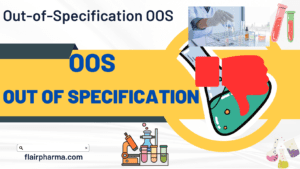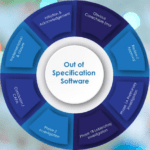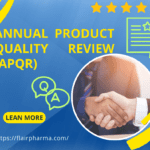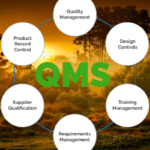Out of Specification (OOS) refers to a condition that occurs in the laboratory of a pharmaceutical plant when a sample, product, or critical parameter fails to meet predetermined specifications or acceptance criteria. It is a deviation from the established quality standards set for pharmaceutical products. OOS results indicate that the observed value or characteristic of the sample is outside the acceptable limits or ranges defined in the specifications.

When an Out of Specification result is obtained, it signifies that the tested sample does not meet the predetermined criteria for attributes such as potency, purity, identity, dissolution rate, content uniformity, or any other critical quality parameter. OOS results require a thorough investigation to determine the root cause and appropriate corrective actions to rectify the non-conforming outcome.
The laboratory personnel in the pharmaceutical plant play a crucial role in identifying and managing OOS incidents. They employ validated analytical methods, rigorous testing procedures, and adherence to Good Laboratory Practices (GLP) to ensure accurate and reliable results. Out of Specification incidents are carefully documented, investigated, and reported as part of the quality control processes to maintain product integrity, regulatory compliance, and patient safety.

The objective of managing OOS incidents in the laboratory of a pharmaceutical plant is to identify and address any underlying issues that may impact the quality, safety, and efficacy of the pharmaceutical products being manufactured. It involves a systematic approach to investigate potential causes, implement appropriate corrective actions, and ensure that subsequent testing and manufacturing processes adhere to the defined specifications and regulatory requirements.
Phases of the Out of Specification in Laboratory of Pharmaceutical Plants
| Phase | Description |
|---|---|
| Phase 1: Identification | After implementing corrective actions, the laboratory conducts a retest to verify if the Out of Specification OOS result can be reproduced. The retesting is performed with heightened attention to ensure the accuracy and reliability of the results. |
| Phase 2: Documentation | In this phase, all relevant details of the Out of Specification OOS result are documented meticulously. This includes the date and time of the test, the specific sample or batch number, the testing procedure employed, and any other pertinent information. |
| Phase 3: Investigation | The investigation phase aims to determine the root cause of the Out of Specification OOS result. It involves a comprehensive analysis of potential factors that could have contributed to the nonconforming outcome. This includes assessing equipment functionality, reagents, sample handling, and potential sources of error. |
| Phase 4: Corrective Actions | Based on the findings of the investigation, appropriate corrective actions are implemented to rectify the issue. This may involve recalibration of equipment, retesting of samples, reviewing analytical procedures, or making necessary adjustments to prevent recurrence. |
| Phase 5: Retesting | Once the investigation and retesting phases are complete, a detailed report summarizing the Out of Specification OOS incident, investigation findings, and corrective actions are taken, and retest results is compiled. This report serves as an essential document for regulatory compliance and internal quality control purposes. |
| Phase 6: Documentation Review | The documentation generated during the entire Out of Specification OOS process is reviewed to ensure completeness and accuracy. This includes a thorough examination of all records, reports, and any additional data generated during the investigation and retesting phases. |
| Phase 7: Reporting | The OOS Out of Specification incident serves as a learning opportunity and continuous improvement measures are implemented to prevent similar occurrences in the future. This may involve revising standard operating procedures, enhancing training programs, or upgrading laboratory infrastructure and equipment. |
| Phase 8: Review and Approval | The OOS Out of Specification report undergoes a review and approval process by designated personnel, which may include laboratory supervisors, quality control managers, and quality assurance personnel. This ensures the accuracy and completeness of the report before it is finalized. |
| Phase 9: Regulatory Reporting | The OOS Out of Specification report undergoes a review and approval process by designated personnel, which may include laboratory supervisors, quality control managers, and quality assurance personnel. This ensures the accuracy and completeness of the report before it is finalized. |
| Phase 10: Continuous Improvement | The OOS Out of Specification incident serves as a learning opportunity, and continuous improvement measures are implemented to prevent similar occurrences in the future. This may involve revising standard operating procedures, enhancing training programs, or upgrading laboratory infrastructure and equipment. |
Example of the Out of Specification OOS in the Laboratory of the Pharmaceutical Plant
| Sample/Batch | Tested Parameter | Specification Range | Observed Result | Conclusion |
|---|---|---|---|---|
| XYZ123 | Potency | 95% – 105% | 88% | OOS |
Explanation: In this example, a sample or batch labeled as “XYZ123” was tested in the laboratory for potency, which should ideally fall within the specified range of 95% to 105%. However, the observed result for potency was determined to be 88%, which is below the acceptable limits. Hence, the conclusion is that the sample is considered Out of Specification (OOS).
Following the identification of the OOS Out of Specification result, the laboratory personnel would proceed with further steps such as documentation, investigation, corrective actions, retesting, and reporting, as outlined in the previous responses.
Please note that this is a simplified example for illustrative purposes, and the actual Out of Specification OOS management process may involve additional details, procedures, and considerations specific to the pharmaceutical plant’s quality control practices and regulatory requirements.
Example of an Out of Specification (OOS) incident for a 2 ml ampoule in a pharmaceutical injectable plant presented in both table and calculation sheet formats:
| Ampoule ID | Tested Parameter | Specification Range | Observed Result | Conclusion |
|---|---|---|---|---|
| XXXXX | Volume | 1.9 ml – 2.1 ml | 2.3 ml | OOS |
Explanation: In this example, an ampoule with the ID “123456” was tested in the laboratory for its volume content. The specification range for the ampoule volume is defined as 1.9 ml to 2.1 ml. However, the observed result for the ampoule’s volume was determined to be 2.3 ml, which exceeds the upper limit of the specified range. Therefore, the conclusion is that the ampoule is considered Out of Specification (OOS) for volume.
Calculation Sheet:
| Ampoule ID: 123456 |
|---|
| Tested Parameter: Volume |
|---|
| Specification Range: 1.9 ml – 2.1 ml |
|---|
| Observed Result: 2.3 ml |
|---|
| Conclusion: OOS |
The calculation sheet provides a summary of the relevant details related to the OOS incident for the ampoule. It includes the ampoule ID, tested parameter (volume), specification range (1.9 ml – 2.1 ml), observed result (2.3 ml), and the conclusion that the ampoule is considered Out-of-Specification (OOS).
Frequently Asked Questions
What is Out-of-Specification in pharma SOP?
Answer: In pharmaceutical Standard Operating Procedures (SOPs), Out-of-Specification (OOS) refers to a specific section or set of instructions that outlines the procedures to be followed when a sample or product fails to meet predetermined specifications or acceptance criteria. The OOS section of a pharma SOP provides guidance on how to handle, investigate, and document OOS incidents within the pharmaceutical manufacturing or testing processes.
What is Out-of-Specification in USP?
Answer: In the United States Pharmacopeia (USP), Out-of-Specification (OOS) refers to a result that falls outside the defined acceptance criteria or established specifications for a specific pharmaceutical product or test. The USP provides monographs and general chapters that outline the standards, methods, and acceptance criteria for various pharmaceutical ingredients, dosage forms, and testing procedures. An OOS result in USP signifies a deviation from the expected quality or performance parameters.
What is the difference between OOS and OOT?
Answer: OOS (Out-of-Specification) and OOT (Out-of-Trend) are both terms used in the pharmaceutical industry to indicate deviations from predefined specifications or acceptance criteria. The main difference lies in the context and time frame of the deviation:
OOS: Refers to a result that falls outside the specified limits or acceptance criteria during the analysis of a sample or product. It is typically associated with a single test result that fails to meet the predetermined specifications.
OOT: Refers to a trend or pattern of results that deviate from the expected or historical data, indicating a potential change or shift in the process or product quality over time. OOT involves monitoring multiple consecutive test results to identify a deviation from the established trend.
What is the OOT limit in pharma?
Answer: The Out-of-Trend (OOT) limit in the pharmaceutical industry is not universally defined and can vary depending on the specific product, test, or regulatory guidelines. The OOT limit is typically established by individual pharmaceutical companies based on their quality control practices and data analysis methods. It is determined by considering factors such as historical data, statistical control limits, product stability, and regulatory requirements. The OOT limit helps in identifying significant trends or patterns in test results that may require further investigation and appropriate actions to ensure product quality and consistency.
What is the definition of Out-of-Specification (OOS) in the context of pharmaceutical plants?
Answer: OOS refers to a condition in which a sample, product, or critical parameter fails to meet predetermined specifications or acceptance criteria established for pharmaceutical products.
What are some common reasons for OOS incidents in pharmaceutical plants?
Answer: OOS incidents can occur due to various factors, including variations in manufacturing processes, raw material quality issues, equipment malfunctions, improper sample handling, human error, or analytical method deviations.
How is an OOS result identified in a pharmaceutical plant laboratory?
Answer: OOS results are identified through rigorous testing and analysis in the laboratory. Samples are tested using validated analytical methods, and any deviations from the established specifications are flagged as OOS.
What is the importance of investigating OOS incidents in pharmaceutical plants?
Answer: Investigation of OOS incidents helps determine the root cause of the nonconforming result, enabling appropriate corrective actions to be taken. It ensures product quality, patient safety, and regulatory compliance.
What are some key steps involved in the investigation of OOS incidents?
Answer: The investigation typically includes a systematic examination of factors such as equipment functionality, raw material quality, formulation discrepancies, environmental conditions, sample handling procedures, and potential sources of error.
What are some examples of corrective actions that can be taken to address OOS incidents?
Answer: Corrective actions may involve equipment recalibration, process adjustments, personnel training, improvements in formulation or manufacturing procedures, or other measures aimed at preventing recurrence and ensuring adherence to specifications.
Why is retesting conducted after implementing corrective actions for an OOS incident?
Answer: Retesting is performed to verify if the OOS result can be reproduced and to ensure that the corrective actions effectively resolved the nonconformity. It validates the effectiveness of the measures taken to bring the sample back within specifications.
How is documentation important in the management of OOS incidents in pharmaceutical plants?
Answer: Documentation plays a vital role in maintaining comprehensive records of OOS incidents, investigations, corrective actions, and retest results. It ensures traceability, accountability, and compliance with regulatory guidelines.
What role does regulatory compliance play in the management of OOS incidents?
Answer: Regulatory compliance is crucial in addressing OOS incidents. Depending on the specific regulatory guidelines, OOS incidents and relevant reports may need to be reported to regulatory authorities to ensure transparency and adherence to regulatory obligations.
How can pharmaceutical plants improve their processes based on OOS incidents?
Answer: OOS incidents provide valuable insights for continuous improvement efforts. Pharmaceutical plants can learn from these incidents and implement measures such as revising standard operating procedures, enhancing training programs, strengthening quality control measures, and fostering a culture of proactive quality management.
You may also read about Microbiology Guidelines



2 thoughts on “Out of Specification OOS in pharma”